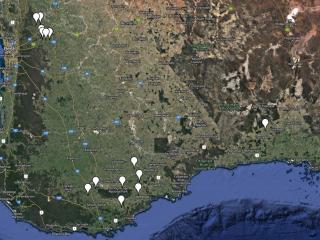Aphid and turnip yellow virus update
Autumn and early winter is a crucial period of the growing season for early season Green peach aphid (GPA) infestation and turnip yellows virus (TuYV) infection in canola. Furthermore, aphid activity during the early part of the growing season generally increases the risk of spread of many other virus diseases in cereal and legume crops.
Ongoing trapping has been occurring at focus sites in Kwinana west, Albany and Esperance port zones (see map below).
Albany port zone findings
High levels of aphid activity have been detected around Tenterden, including cabbage aphids carrying TuYV.
Moderate levels of aphid activity have been detected around South Stirling and Amelup.
GPA has been detected around South Stirling. No TuYV has been detected at these sites so far.
Low levels of aphid activity have been detected around Cranbrook, Gnowellen, Ongerup and Monjebup with GPA detected around Gnowellen. No TuYV has been detected at these sites so far.
Esperance port zone
Minimal aphid activity has been detected around Mount Howick, Beaumont and Cascade. No green peach aphid or TuYV detected at these sites so far.
Kwinana-west port zone
Moderate levels of aphid activity detected around Clackline, Toodyay and Muresk. Neither GPA nor TuYV have been detected at these sites so far.
The surveillance team will continue to provide updates throughout June and July.
Management
Growers are reminded to monitor their canola crops for aphids or plants displaying TuYV symptoms.
If you see aphids colonising canola crops, or plants that look symptomatic that you are concerned about, they can be tested for the presence of TuYV through the Department’s Diagnostic Laboratory Services – Pathology Services.
For insecticide recommendations, refer to DPIRD’s 2022 autumn winter insecticide guide.
To reduce the risk of resistance to any insecticide group, it is important to rotate insecticides with different modes of action, avoid the use of broad-spectrum insecticides and apply appropriate insecticides only after careful monitoring and correct identification of species. Growers and advisors are encouraged to download and follow GRDC’s GPA Resistance Management Strategy to minimise the further development of insecticide resistance.
To read about earlier aphid and TuYV activity this season refer to the PestFacts WA Issue 4 article Aphid activity and turnips yellows virus detections.
For more information refer to DPIRD’s Turnip yellows virus in canola: diagnosis and management page.
For further information contact Research scientist Benjamin Congdon, South Perth on +61 (0)8 9368 3499.
Article authors: Benjamin Congdon (DPIRD South Perth) and Cindy Webster (DPIRD Narrogin).


